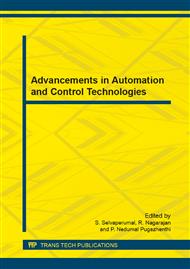p.722
p.728
p.734
p.741
p.747
p.757
p.767
p.777
p.785
Three Phase Power Flow Incorporating Static Var Compensator
Abstract:
Application of Flexible AC Transmission Systems (FACTS) devices in a power system is a promising and more efficient way for the transfer and control of bulk amount of power. One of the problems encountered in power-systems operation is the generation of unbalanced voltages and currents in the presence of long transmission lines with few or no transpositions. This includes possible unbalances arising in source and load conditions, or indeed any items of plant such as shunt and series reactors. To improve or investigate these unbalance effects in any detail, a 3-phase load-flow solution that allows representation of all possible unbalances as they exist in the power-systems network without making any assumptions is essential. This paper deals with the three phase power flow incorporating Static Var Compensator (SVC). Here SVC is modeled using variable reactance modeling technique and incorporated into the single phase and three phase load flow. Newton Raphson power flow algorithm is adopted here. The performance of SVC to control the power flow and regulating voltage in the network is discussed. The performance analysis is carried out for 4 case studies namely single phase power flow, single phase power flow with SVC, three phase power flow and three phase power flow with SVC. The change in power flow and losses due to the unbalanced load condition in the three phases in illustrated. The studies are carried out in a standard 5 bus test system. Keywords: Three Phase Power flow, Static Var Compensator, Unbalanced system, Negative sequence components, Zero sequence components.
Info:
Periodical:
Pages:
747-756
Citation:
Online since:
June 2014
Authors:
Price:
Сopyright:
© 2014 Trans Tech Publications Ltd. All Rights Reserved
Share:
Citation:


